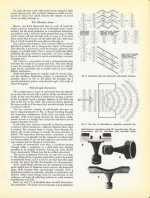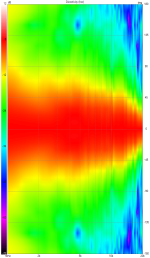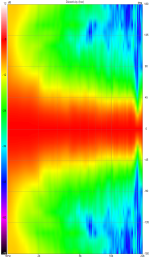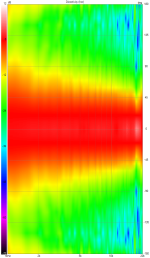Looking at all the various designs of HF dispersion lenses for a large format monitor application.
Have there been any improvement in lens design over the last decade or so compared to the traditional stacked / scalloped type of lens?
Have there been any improvement in lens design over the last decade or so compared to the traditional stacked / scalloped type of lens?
gedlee experimented with using graded reticulated foam as a lens, and seems to be someone worth discussing lenses with.
https://www.diyaudio.com/community/threads/how-to-build-large-round-front-horns.154447/post-2099056
https://www.diyaudio.com/community/threads/how-to-build-large-round-front-horns.154447/post-2099056
I'll check that out. The WG I'm dealing with in this situation is the popular Faital STH100 with the Faital HF108 running from 4k on up. Its obviously a good WG but it beams a bit at 10k+. I was expecting more horizontal dispersion being its a small WG, but I guess the tractrix profile will make it do that.
The traditional JBL style lenses look too big for this small of a WG mouth. There are some people who have made their own lens from laser cut aluminum sheets. Not sure how good these are compared to commercially made units.
The traditional JBL style lenses look too big for this small of a WG mouth. There are some people who have made their own lens from laser cut aluminum sheets. Not sure how good these are compared to commercially made units.
I dont think that was intended to control dispersion but rather mitigate HOMs (reflections) in the throat of the horn/wg...gedlee experimented with using graded reticulated foam as a lens, and seems to be someone worth discussing lenses with.
https://www.diyaudio.com/community/threads/how-to-build-large-round-front-horns.154447/post-2099056
//
No, Earl talked on several occasions about using the varying refractive index of different foams to control directivity. It was intended to be the topic of his masters thesis. He even mentioned it was the (minor) reason he shaped the foam rounded on the outer surface once he had decided to use it for HOM control, since it made sense from a dispersion point of view.I dont think that was intended to control dispersion but rather mitigate HOMs (reflections) in the throat of the horn/wg...
//
Long time ago we had slant-plate and corrugated-plate JBL lenses. Didn't like the sound of either of them, nor of Altec multi-cellular horns (but for different reasons). The JBL lenses sounded like vibrating plates adding distortion, at least at higher SPL.
@AllenB I also thought the foam was solely to form a homogenous wave front and not for dispersion purposes, but I guess its possible to do both if you can influence the wave propagation.
@Markw4 I agree with you regarding the SQ issues with traditional lenses. They rattle and resonate badly at higher SPLs. I was wondering if some highly dampened plates would be considerably better sounding, enough to mitigate the issue. There is the dynamat type of material which could serve this purpose, then adjust the spacing according to desired bandwidth. It could work, but there's the issue of figuring out the cutout shape / geometry to allow a shorter path by the an axis sound. I'm sure there's a way to calculate this, but I've never seen any formulas for it.
@Markw4 I agree with you regarding the SQ issues with traditional lenses. They rattle and resonate badly at higher SPLs. I was wondering if some highly dampened plates would be considerably better sounding, enough to mitigate the issue. There is the dynamat type of material which could serve this purpose, then adjust the spacing according to desired bandwidth. It could work, but there's the issue of figuring out the cutout shape / geometry to allow a shorter path by the an axis sound. I'm sure there's a way to calculate this, but I've never seen any formulas for it.
Shockwave welding of dissimilar metals into plates might do it. The different layers would have different natural resonances (due to different propagation velocities), and thus could tend to dampen each other. Don't know who makes such a material though. Or maybe carbon fiber by itself and or if it could be laminated with metal. Something like that, which is to say something strong yet naturally dampened.
If foam was the means to control dispersion in a good way, I think we would have seen more of it.
//
//
The sonic quality of diffraction becomes worse at higher SPLs even without rattles.I agree with you regarding the SQ issues with traditional lenses. They rattle and resonate badly at higher SPLs. I was wondering if some highly dampened plates would be considerably better sounding, enough to mitigate the issue.
The JBL 2301, 2390, 2391, 2392, and 2395 wavefront diffraction plates/grates are perhaps the worst examples of using diffraction to increase dispersion.
The most charitable thing I'd say about this type of horn/lens design is they add a "warm, fuzzy" aspect not originally in the source.
I'd far prefer the sound of a single "pinched throat" diffraction element to achieve wide HF dispersion to the multiple diffraction paths of the horn/lens.
That said, eliminating the diffraction element is better yet.
Horns made with Mabat's Ath4 profiles have far better polar response than the JBL horn lens family, and don't require diffraction to achieve wide dispersion past 16kHz.
This one is 12" in size, 100° constant directivity coverage:
https://www.diyaudio.com/community/...the-easy-way-ath4.338806/page-34#post-5980566
I think (hard to verify) these horn profiles also provide more gain than the JBL horn/lens family, so the drivers don't have to be driven as hard for a given SPL.
Art
Last edited:
Yes, I have to agree with you. Any diffraction based WG gets sizzly at higher SPL. The smaller the WG, the worse the sizzle factor. Im definitely not a JBL WG fan except for the biradial designs used in the 44 series monitors. I just like smaller WGs for HF in high efficiency 3 way systems used in hifi and monitor applications. I know most people would just build a large 2 way, but I don’t like the sound of most compression drivers crossed between 1 - 3k.
Hi, coffee break post:
You could use the driver without the horn to get quite wide coverage all the way up except for top octave perhaps. In general, coverage of top octave is defined by about top octave sized stucture (1-2cm or 1/2-1") which is basically size of the transducer and in this case the throat portion of the driver and waveguide. You could imagine beaming horns such as STH100 would project the highs from the throat, there is very little highs at the horn mouth edge, it as the throat already controls the highs effectively and beam from within. Otherwise you would have wider coverage on top octave, if those short wavelengths ever touched the mouth you'd measure wider coverage radiation, and this means the throat must change to allow highs to the mouth edge. Foams and other add-ons could make a difference but not sure if it's for better, or just transforming one problem to another, better fix it where it all begins if possible. This means, use better waveguide, better to your expectations.
Use (smallest) transducer you like to have widest possible coverage on top octave, and then optimize the structure (waveguide) to avoid diffraction and have coverage you want. Doens't matter if you like domes or ribbons or compression drivers, you'd still could / should optimize the structure, think waveguide. This is not something specific for PA speakers, or studio speakers, or homespeakers, they all work with same acoustics and with our auditory systems and all of the applications and implementations benefit acoustically good structure around the transducers if sound quality is more important than cost and complexity.
If you have some SPL requirements and want high crossover it's now a three way system, perhaps four way system if you want to optimize for room. Now that you have an idea of the tweeter system, next step figure out what kind of mid could work and what kind of structure for it would work acoustically and still meet your overall goal for the system. Then what kind of a bass system would work then, acoustically. You'd want to avoid or optimize diffraction like any other issues all the way. You might want to consider whether mid ruins reponse of tweeter and so on, depending how far you wanna go with it, what matters and what doesn't 🙂
This is basic loudspeaker design stuff basically, have some "requirements" and work your way through. What ever you do you would want to optimize the structure acoustically, which is something many people don't seem to pay much attention to. Basically it's eliminating of secondary sound sources, or optimizing them in a way that they support what is it you want to achieve, instead of hindering. It is likely there is going to be some secondary sound sources in the system no matter how much you optimize (diffraction, reflections, resonances), but it's much wiser try to optimize them somehow than never even paying a thought. So, you already have a head start as you have laid out a thought for acoustics and went as far as started a thread for it 🙂
You could use the driver without the horn to get quite wide coverage all the way up except for top octave perhaps. In general, coverage of top octave is defined by about top octave sized stucture (1-2cm or 1/2-1") which is basically size of the transducer and in this case the throat portion of the driver and waveguide. You could imagine beaming horns such as STH100 would project the highs from the throat, there is very little highs at the horn mouth edge, it as the throat already controls the highs effectively and beam from within. Otherwise you would have wider coverage on top octave, if those short wavelengths ever touched the mouth you'd measure wider coverage radiation, and this means the throat must change to allow highs to the mouth edge. Foams and other add-ons could make a difference but not sure if it's for better, or just transforming one problem to another, better fix it where it all begins if possible. This means, use better waveguide, better to your expectations.
Use (smallest) transducer you like to have widest possible coverage on top octave, and then optimize the structure (waveguide) to avoid diffraction and have coverage you want. Doens't matter if you like domes or ribbons or compression drivers, you'd still could / should optimize the structure, think waveguide. This is not something specific for PA speakers, or studio speakers, or homespeakers, they all work with same acoustics and with our auditory systems and all of the applications and implementations benefit acoustically good structure around the transducers if sound quality is more important than cost and complexity.
If you have some SPL requirements and want high crossover it's now a three way system, perhaps four way system if you want to optimize for room. Now that you have an idea of the tweeter system, next step figure out what kind of mid could work and what kind of structure for it would work acoustically and still meet your overall goal for the system. Then what kind of a bass system would work then, acoustically. You'd want to avoid or optimize diffraction like any other issues all the way. You might want to consider whether mid ruins reponse of tweeter and so on, depending how far you wanna go with it, what matters and what doesn't 🙂
This is basic loudspeaker design stuff basically, have some "requirements" and work your way through. What ever you do you would want to optimize the structure acoustically, which is something many people don't seem to pay much attention to. Basically it's eliminating of secondary sound sources, or optimizing them in a way that they support what is it you want to achieve, instead of hindering. It is likely there is going to be some secondary sound sources in the system no matter how much you optimize (diffraction, reflections, resonances), but it's much wiser try to optimize them somehow than never even paying a thought. So, you already have a head start as you have laid out a thought for acoustics and went as far as started a thread for it 🙂
Last edited:
I hear what you're saying from a common sense standpoint. It never appears to be as simple as polishing a turd and being successful at making it not smell like one despite disguising it.
The STH100 is a very good sounding WG and responds well to EQ. Sometimes just a little bit of top octave boost is all thats needed to get a little more off axis sparkle. Most super tweeters don't really do any better off axis unless they use diffraction, which doesn't sound good to my ears.
The STH100 is a very good sounding WG and responds well to EQ. Sometimes just a little bit of top octave boost is all thats needed to get a little more off axis sparkle. Most super tweeters don't really do any better off axis unless they use diffraction, which doesn't sound good to my ears.
Hi,
I've attached HF10AK compression driver in three different freestanding waveguides including STH100.
As you see the top octave is on mercy of throat of the driver and has some issues on all of these. To get the top octave better needs experimentation or accurate simulations, or making the throat smaller and hoping it'll be fine. What I mean making throat smaller is that this particular driver has 1" opening to interface a 1" waveguide, but the driver really has 3/4" opening which extends into 1", there about 1" long conical exit section. This would allow a stub to be inserted inside the driver to utilize the actual 3/4" throat size, interface proper waveguide from there on, and get the top bit better.
Besides just the actual top octave these waveguides have quite different overall directivity. The smoother the directivity the more adjustable the top is in general as the speaker would sound pretty much the same (frequency balance wise) from any reasonable listening axis. Now one can EQ the top to liking. If system beams too much it might be difficult to adjust with EQ, as suitable balance is only at some particular listening axis and EQ changes the axis but doesn't widen it. So, basically toe-in becomes very important factor to balance frequency response but now the room interaction cannot be optimized with toe-in anymore. Directivity sets frame what toe-in (listening axis) work, and how much there is leeway to change the toe-in one way or another still maintaining frequency balance. This in turn determines how much you can adjust the room sound with toe-in, in addition.
So, if you can adjust the system with EQ and toe-in then that's fine, you have it nice. If you find there is something wrong no matter how you tune it the problem must be directivity in relation to your application. Directivity can be changed only by swapping the waveguide and this is what you ask for, right? you'd need to figure out what's the problem in order to improve on it.
I've attached HF10AK compression driver in three different freestanding waveguides including STH100.
As you see the top octave is on mercy of throat of the driver and has some issues on all of these. To get the top octave better needs experimentation or accurate simulations, or making the throat smaller and hoping it'll be fine. What I mean making throat smaller is that this particular driver has 1" opening to interface a 1" waveguide, but the driver really has 3/4" opening which extends into 1", there about 1" long conical exit section. This would allow a stub to be inserted inside the driver to utilize the actual 3/4" throat size, interface proper waveguide from there on, and get the top bit better.
Besides just the actual top octave these waveguides have quite different overall directivity. The smoother the directivity the more adjustable the top is in general as the speaker would sound pretty much the same (frequency balance wise) from any reasonable listening axis. Now one can EQ the top to liking. If system beams too much it might be difficult to adjust with EQ, as suitable balance is only at some particular listening axis and EQ changes the axis but doesn't widen it. So, basically toe-in becomes very important factor to balance frequency response but now the room interaction cannot be optimized with toe-in anymore. Directivity sets frame what toe-in (listening axis) work, and how much there is leeway to change the toe-in one way or another still maintaining frequency balance. This in turn determines how much you can adjust the room sound with toe-in, in addition.
So, if you can adjust the system with EQ and toe-in then that's fine, you have it nice. If you find there is something wrong no matter how you tune it the problem must be directivity in relation to your application. Directivity can be changed only by swapping the waveguide and this is what you ask for, right? you'd need to figure out what's the problem in order to improve on it.
Attachments
Last edited:
I failed to communicate, that different driver that has better throat embedded, that makes nicer wavefront before waveguide, might not have the pinch on the top you see on my graphs on STH100 and ST260 , where wavelength is shorter than throat diameter. So, if your system doesn't measure a pinch like mine, your driver is likely fine and directivity of the waveguide is likely too narrow to your liking and you'd might want to try the ST260 for example, see ATH thread. If you have the pinch as well and it is that you are hearing, then you might want to try some other driver with STH100. I know my hearing isn't particularly good that high so haven't seen that pinch a problem and think that the overall directivity is more important in relation.
- Home
- Loudspeakers
- Multi-Way
- Best type of acoustic HF lens for large format monitors



